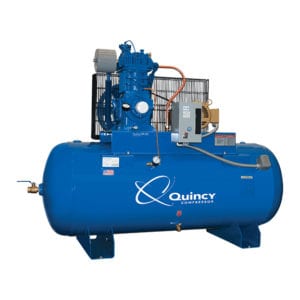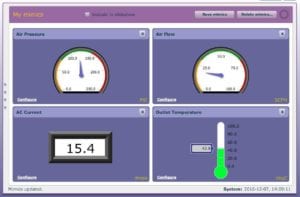Compressor Measurement Systems Uses dataTaker DT80
Compressed air is a power source used by nearly all manufacturers worldwide. The energy use of compressed air systems is typically a significant part of the overall power consumption of a facility. From a business standpoint, it’s critically important to select a system with the correct capacity to optimize air compressor efficiency; if the selected compressor is too large then it will only operate occasionally and still consume a lot of power even when idling. If the system is too small or if there are losses due to leakage, the system can be running at full capacity all of the time which again increases costs.

A company specializing in compressor installation came to CAS asking how they could assemble a system to check air compressor efficiency. They required a small but powerful data acquisition unit to record multiple parameters:
- On/off time of the system
- AC current consumption
- Line air pressure
- Airflow
- The temperature at several points
Installation
 This system needed to be easy for field personnel to operate with simple software. CAS DataLoggers provided the compressor company with a dataTaker DT80 Universal Input Data Logger, split-core AC current clamps, pressure transducers, an inline airflow sensor, and thermocouple probes. Additionally, a panel mount display was attached to the data logger to provide a real-time display of measured values plus trend charts showing data collected over the last 24 hours.
This system needed to be easy for field personnel to operate with simple software. CAS DataLoggers provided the compressor company with a dataTaker DT80 Universal Input Data Logger, split-core AC current clamps, pressure transducers, an inline airflow sensor, and thermocouple probes. Additionally, a panel mount display was attached to the data logger to provide a real-time display of measured values plus trend charts showing data collected over the last 24 hours.
The installation of the system was straightforward. First, a field engineer places the split core current clamps around the power cables going to the compressor motor. The current sensors allow both compressor run-time and current consumption to be recorded. During the set-up, current thresholds were set to determine when the compressor was idle vs. when it was running under load. The pressure transducer was installed in an existing NPT tap. The flow sensor was installed in the main supply line by drilling two small holes using the guide provided with the sensor and then clamping the sensor around the pipe. Thermocouple probes were clamped to the pipe at several locations to monitor temperature, for example, the discharge temperature at the outlet of the compressor. The dataTaker data logger was programmed to sample the data every minute, recording the current level, whether the compressor was running under load, the outlet pressure and airflow, and the temperatures.
Usage
Using this data, the facility was able to identify several issues with the air compressor efficiency of its compressed air system. First, they found that the compressor was running near full load during most of the day indicating that the system was probably undersized for the facility. Second, they identified that the system was cycling on and off during times when the plant was not in operation and that the airflow was unexpectedly high even when the equipment was not in operation. After some detective work, they found several pieces of equipment that were leaking air internally.
The dataTaker data logger has analog, digital, and serial data recording capabilities, allowing up to 15 analog inputs to be used in many combinations. These universal inputs enable connection to most sensors so that current/voltage, pressure, flow temperature, or nearly any physical or electrical value can be logged and scaled into engineering units. Additionally, the dataTaker’s durability provides years of reliable operation, and the logger’s large memory stores up to 10 million data points for extended logging sessions.
Software
Built-in dataTaker dEX software is included with the dataTaker data logger and uses a Windows Explorer-style graphical interface allowing quick setup and configuration of the data logger. Using the Modbus communication capabilities of the logger to send the data to an HMI allows an engineer to view all measurements in real-time and display them in several different formats including gauges and trend charts.

Benefits
At the end of the energy survey period, the manufacturer used the collected run-time and current consumption data to determine if the compressor is of the correct size and if there are other issues impacting efficient operation. Here the DT-80 serves as a single solution to log run-time and current consumption while also containing the necessary software for data analysis and report generation. The manufacturer’s energy surveys take much less time now that the readings are taken and extracted from one system so users don’t need to spend time learning multiple devices and software packages. This helps them to more quickly find out if their compressors are of the correct size and maximize their air compressor efficiency.
For more information on our dataTaker Intelligent Data Loggers, and air compressor efficiency or to find the ideal solution for your application-specific needs, contact a CAS DataLoggers Application Specialist at (800) 956-4437 or request more information.

